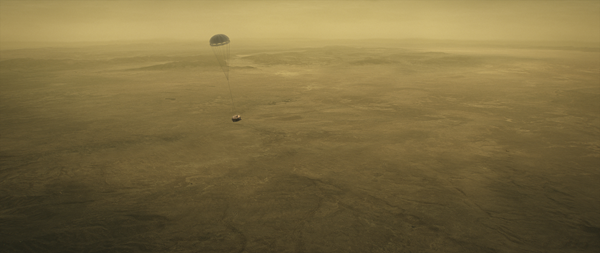
Key Takeaways:
- The Huygens probe, part of the Cassini-Huygens mission, successfully landed on Titan despite significant uncertainties regarding the surface conditions, demonstrating a robust design capable of withstanding unknown landing scenarios.
- Huygens's atmospheric descent provided crucial in-situ data on Titan's atmospheric composition, temperature, pressure, and wind patterns, creating a one-dimensional profile from the upper atmosphere to the surface.
- The probe's surface images revealed a landscape featuring riverbeds, drainage networks, and rounded cobblestones, suggesting past or present liquid flow and erosion processes, while also detecting liquid on the probe itself.
- While communication challenges with Cassini resulted in data loss, the acquired data revolutionized our understanding of Titan's geology, atmospheric evolution (including the origin of its methane and argon isotopes), and the potential for prebiotic chemistry, establishing Huygens as a pivotal mission in Titan research.
When the Huygens probe dropped into Titan’s atmosphere January 14, 2005, no one knew what to expect. Would it splash down into a methane ocean? Sink into a tar pit? Crash into sharp rocks or tumble off a ravine? And, most importantly, what manner of world lurked beneath Titan’s thick shroud of haze and clouds?
For landings on Mars or the Moon, mission scientists plotted out landing sites with meticulous care. Telescopes and orbiters scanned the ground, imaging dangerous terrain and safe zones, and flight engineers pored over their maps and planned accordingly.
But Titan was a mystery. Aside from a brief pass by Voyager 1, little was known about Saturn’s largest moon. What the Huygens descent probe would find was anyone’s guess. Huygens had to be prepared for anything.
Alex Hayes, a Titan researcher at Cornell University who has been part of the Cassini orbiter team since the craft’s arrival at Saturn, is enthusiastically proud of the probe’s success, though he didn’t work with Huygens himself. “No matter what data Cassini collects over the 13 years of its mission, there is something special about reaching out and touching something,” he says. “There’s something special about landing on the surface, about getting data from the surface, and Huygens provided that ground truth.”
Planning for the unknown
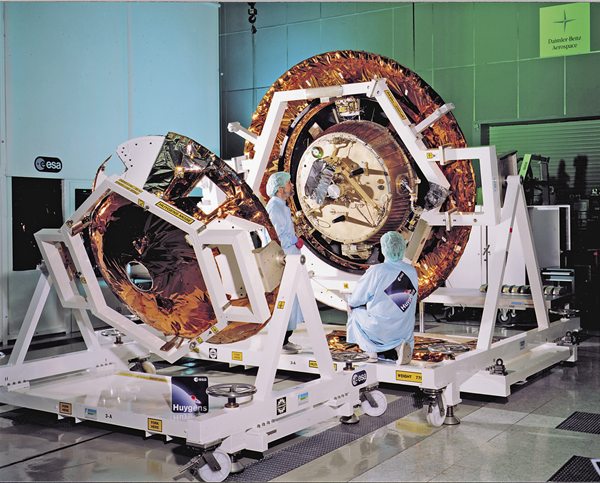
Huygens was the European Space Agency’s contribution to the greater Cassini-Huygens mission. With very few exceptions, all of Huygens’ instruments and components were built by individual members of ESA, culminating in one magnificent spacecraft.
While Huygens did touch down and collect data on Titan’s surface, that outcome was far from certain. When Voyager 1 passed by the moon in 1980, it couldn’t peer through Titan’s thick atmosphere and obscuring clouds. The best it could offer was a tantalizing reveal that Titan sported organic materials, which led to the understanding that it was possibly covered in oceans made of methane or ethane. Later, the massive Goldstone radio telescope received radar echoes from Titan indicating that at least some solid surface existed under the clouds.
But without any mapping of Titan’s surface, and limited control over where Huygens might land, the mission team designed the craft for any condition. Engineers built Huygens light enough to float and with enough battery life to operate for at least a short while on the surface — assuming it survived impact. But overall, engineers designed a descent probe: Huygens would collect all of its primary science during a fall through Titan’s atmosphere lasting two to two and a half hours. Whatever it did or didn’t see afterward would be a fabulous bonus.
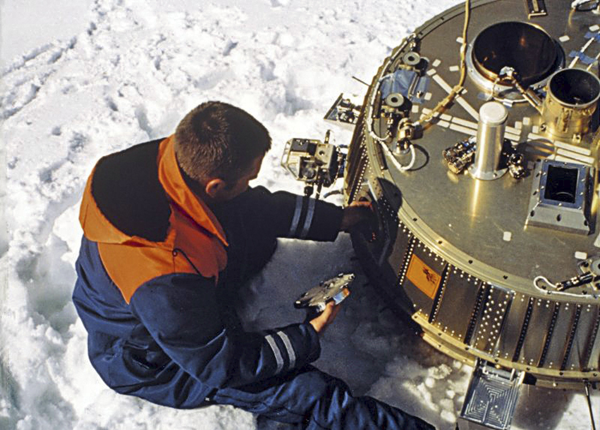
Engineers at Caltech even had a betting pool going for what Huygens would find on touchdown, with options for “ice,” “tar,” “liquid,” “undeterminable,” “DOA,” and even a facetious vote for “eaten” — as in by sea monsters.
To conduct its science, Huygens was equipped with six main instruments, aimed to answer a slew of questions: What gases make up Titan’s atmosphere, and what kinds of particles, hazes, or clouds float there? What chemicals churn through the skies? How warm or cool is the atmosphere, and how do global wind patterns flow? What does the top of the atmosphere look like and how does it behave, including the ionosphere? And what are conditions like at the bottom of the atmosphere, just above or — fingers crossed — at the surface?
Huygens carried an aerosol collector to sample tiny particles floating through Titan’s skies and a spectrometer to analyze the gases making up the air it sailed through. Another instrument measured the physical properties of its surroundings: temperature, pressure, the probe’s speed, and how hard it might impact the ground or the rocking motion of Titan’s waves if it hit liquid. It could even measure how the winds pushed it across Titan’s skies. It carried a whole package of sensors to analyze whatever it landed on, be it liquid sea or solid ground.
And, of course, Huygens included a camera, to reveal what is still the most distant world on which humans have landed a spacecraft.
Can you hear me?
While the Huygens mission was a rousing success, it had two notable hiccups, both related to communications issues between the probe and Cassini, its relay to Earth.
In 2000, with Cassini well into its journey toward Saturn, an engineer took it upon himself to test the communications on the spacecraft. He pinged Cassini with a simulated message from the Huygens’ engineering model on Earth, hoping to receive it back. He did receive a response, but it was gibberish.
The flaw turned out to be in the way the receiver on Cassini handled Doppler shifting of signals it received. As the craft moved, any signals approaching it would shift in frequency, the same way a siren rises and falls in pitch as it speeds toward and away from a listener. Cassini’s receiver for communication with Huygens could not adjust for these changes. Worse, the receiver’s abilities were locked in, and Cassini was already hundreds of millions of miles away.
Luckily, the team had four years to work on a solution. If the receiver couldn’t handle Doppler shifting, then the team would avoid motions that caused such shifts. But this meant changing how the orbiter and probe would maneuver through the Saturn system. Instead of releasing Huygens on its first Titan pass, Cassini would now cart Huygens along for a few Titan flybys, slowing down with each pass until it could release the probe more gently, on a path that minimized the Doppler shifting of the probe’s transmissions. Another solution called for the probe to “wake up” earlier than initially planned after separating from Cassini, since the temperature of the instrument also influenced the signal.
Although these changes used up precious fuel (for Cassini) and battery life (for Huygens), the spacecraft had reserves of both. And they were well worth it to avoid Cassini relaying nothing but nonsense from Huygens’ precious stream of data. By the time Cassini arrived at Saturn, the new plan was well in place.
But this wasn’t the end of the mission’s communications problems. Only after Huygens was well into its descent at Titan did operators notice that only one of Cassini’s two channels was relaying information from the probe. Huygens was meant to send information over both of Cassini’s channels, Channel-A and Channel-B. But Cassini’s programming was missing a crucial command to turn on the Channel-A receiver.
While critical data was duplicated on both channels, and some other transmissions were eventually recovered directly by Earth-bound receivers, much other information, including half of Huygens’ images, was lost forever. Even so, the information that Huygens sent back was enough to take Titan from fuzzy orange ball to a fully realized world, in the span of only a few hours.
Geronimo!
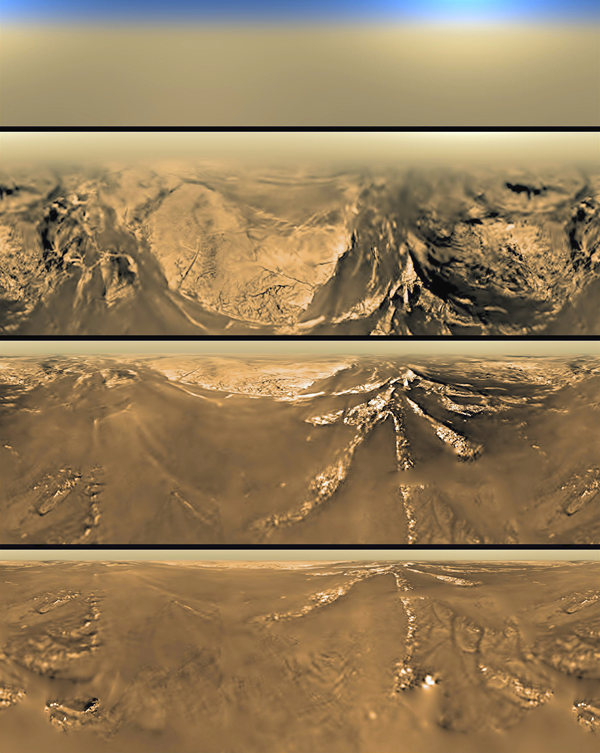
Cassini released Huygens December 24, 2004, nearly six months after first entering Saturn’s orbit. The probe then underwent a sleepy, three-week fall through space before encountering Titan’s atmosphere. The last the mission team ever saw of the probe was an image snapped by Cassini shortly after decoupling.
Far from reassuring, the ESA team found the sight eerily reminiscent of the picture captured by the Mars Express orbiter the previous year of the Beagle 2 probe, just before it disappeared while dropping to the Red Planet’s surface. That craft would not be found for 12 years.
“When Cassini took the image of Huygens on its descent, we had to hope that wasn’t the last we saw of Huygens,” recalls Ralph Lorenz, a member of the Huygens team who has also written numerous books on the subject.
Huygens entered the atmosphere enclosed in a heat shield to protect it from the strain of entry. After it passed through a danger zone, it ejected the back cover and deployed its large parachute. Once stabilized, Huygens blew off its front heat shield, ready to start its science mission.
Huygens immediately started analyzing and recording, snapping its first image as it drifted 89 miles (143 kilometers) above Titan’s surface. It sampled the atmosphere as it passed through, measuring electrical signals and cataloging its journey in detail.
After 15 minutes, Huygens ejected its main parachute and continued descending under a smaller chute. Mission engineers had planned this switch-over to allow Huygens to explore the upper atmosphere first, then descend more quickly so it would still have battery life by the time it reached the ground, if it survived.
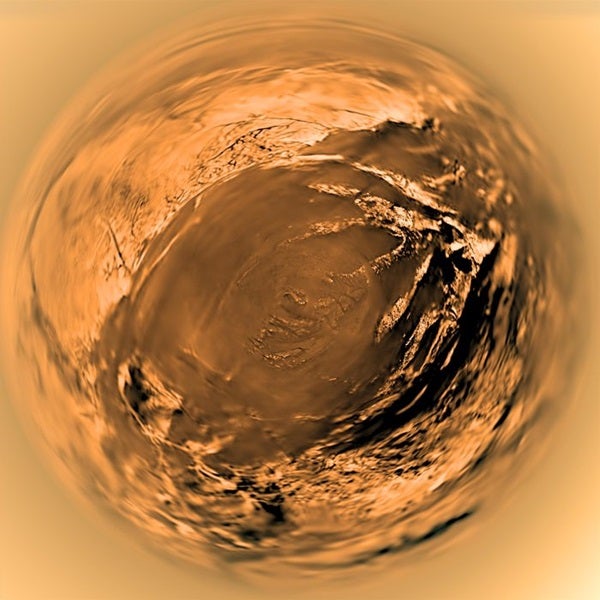
Huygens continued collecting data as it descended more rapidly through Titan’s haze and clouds, encountering some turbulence on the way — nothing the little probe couldn’t handle.
As luck would have it, Huygens did not land on sharp rocks or hard ice, which might have crumpled the craft. Neither did its parachute obstruct its view — a concern held by a few members of the mission team. It did not splash down in any of Titan’s numerous lakes or seas. Instead, it thumped gently down onto a bed of something with the consistency of damp sand or packed snow, the ground around it strewn with rocks and pebbles that wouldn’t look out of place on an earthly lakeside beach.
Safely aground, Huygens continued its mission. It assiduously recorded image after image of its final resting place for 72 minutes after touchdown. In all, it sent back some 100 pictures of the same slice of terrain before Cassini and its link to Earth disappeared over Titan’s horizon. A short time later, its batteries ran out, and the probe quietly shut down.
A picturesque landscape
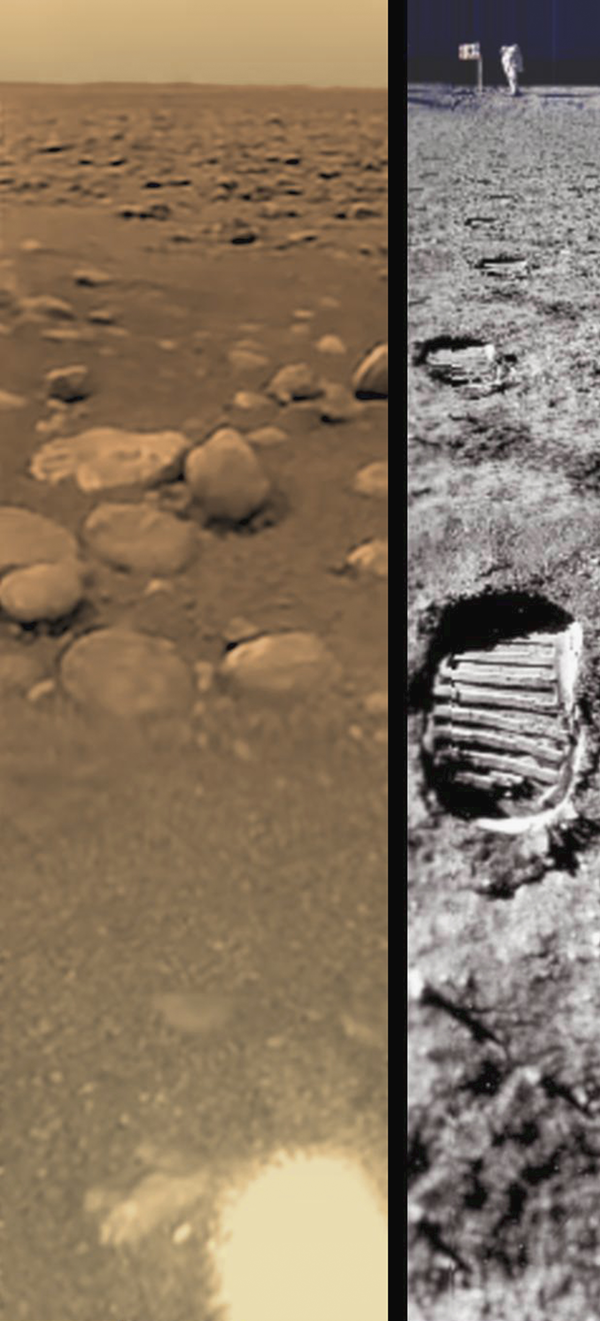
From the first images, Huygens forever changed scientists’ understanding of Titan. Its pictures showed riverbeds — channels cut clearly into Titan’s face. These rivers showed drainage networks similar to those found all over Earth: small channels feeding into larger rivers, which empty out into flat deltas.
Bright highlands showed rough, jagged terrain. Steep river valleys and canyons indicated that Titan’s rivers could be prone to flooding, and likewise showed signs of methane rain erosion. Other riverbeds hinted at gentler streams. Scientists think these are fed not by rainfall but from “spring sapping,” where liquid methane wells up through the ground.
Closer up, Huygens took stock of its landing site. The probe touched down on a dark plain. While it saw no sign of current surface liquid, the region strongly resembled a dried lake bed or floodplain. Scattered around Huygens’ base were cobblestones, edges rounded as if shaped by flowing liquid. The stones are of a similar size, implying that the same currents might have moved all of them, but scientists remain unsure whether this is the case.
Hayes points out that the rounded cobbles near Huygens’ landing site appear like stones ground smooth by a river carrying them over distance. But on Earth, a river drops larger stones earlier in its path, then smaller stones as the flow begins to peter out. “What intrigues me personally,” Hayes says, “is that in the decade since those images and data were taken, we started to question everything, or find that every answer you get leads to three new questions.”
Huygens quite literally scratched Titan’s surface. And by opening up an entire new world to researchers, it also jump-started a new generation of research, inviting questions by the thousands. Scientists then and now look to Huygens as the only eyewitness to an entire complex world, but studies are limited by the short time and tiny area the probe could explore.
So far from the Sun and under Titan’s hazy skies, Huygens took its pictures in a twilight sort of lighting. At one point, its vision included a dewdrop that formed on the probe’s exterior. While probably induced by Huygens itself and the heat from its landing, the single drop was nonetheless the first in situ sighting of liquid on a world other than Earth.
Collecting gases
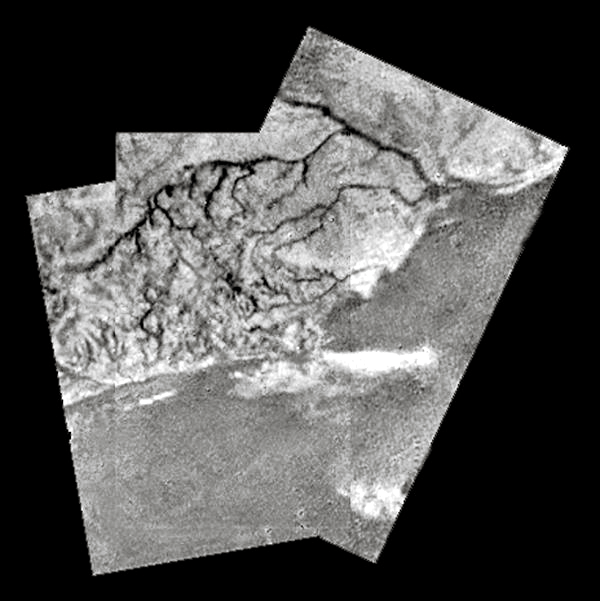
On its way down, Huygens sampled the gases circulating in Titan’s atmosphere and confirmed they were mostly nitrogen and methane. More importantly, it measured the temperature, pressure, and abundance of gases from the atmosphere’s top all the way to the ground, creating a one-dimensional map of Titan’s skies. It revealed high levels of stratification, passing from one zone to another as it fell.
One of Huygens’ goals was to hunt for noble gases, such as argon. Noble gases are chemically disinclined to join with other elements to form compounds, so their abundances hint at long histories, stretching back to the availability of these gases at the birth of the solar system. Their presence helps scientists understand how Titan’s atmosphere came to be — and, likewise, how other worlds like Earth might have attained similar thick atmospheres.
But Huygens, despite descending quite literally through the thick of things, detected low abundances of argon compared with nitrogen, especially a particular isotope known as argon-36. Huygens found it roughly a million times less abundant than in the Sun, implying that Titan could not have gathered its atmosphere directly from the early solar nebula. Instead, its atmosphere was likely delivered by bombardments of space rocks, bolstering the case for Earth’s atmosphere forming in the same way.
On the other hand, detection of another isotope, argon-40, tells a different story. This isotope arises from the radioactive decay of potassium found in rocks. For Huygens to sniff out such a gas in the atmosphere implies that Titan must have a way to release it: an active geologic, or at least cryologic, cycle where rocks or ice are churned from Titan’s depths to its surface and atmosphere, and released by ice volcanoes. But whether this process is powered by Titan’s own internal heating mechanisms, by the heat of Saturn’s tidal pull, or even if the process truly exists at all is still under debate.
While Voyager’s original methane discovery had raised the faint specter of alien biology as its origin, Huygens laid these hopes mostly to rest. Scientists knew that some kind of activity must refresh Titan’s methane stores, or else sunlight would destroy the gas in a matter of a few million years. But the arrangement of methane layers in Titan’s atmosphere, coupled with the carbon isotopes Huygens sampled, indicated once again that geologic processes were the likely methane source.
However, in Titan’s haze layers, Huygens detected molecules similar to tholins produced in earthly laboratories. Tholins are thought to be important to the development of life on Earth, and the complex carbon molecules are a source of active research. Their presence on Titan is an encouraging sign that the building blocks of life are not unique to Earth.
Small craft, big contribution
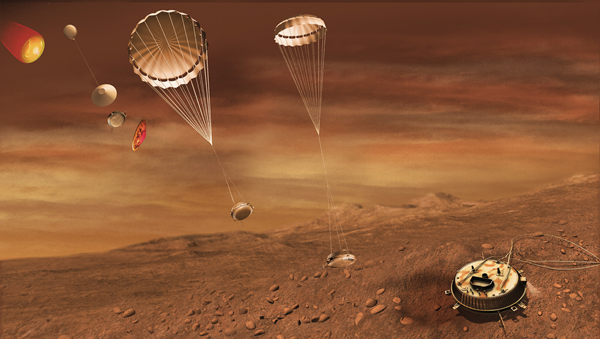
While Huygens’ science mission lasted a fraction of Cassini’s decade-plus adventure, its contributions were mammoth. It remains the only human-made craft to touch the face of any moon other than our own. And its “come what may” design approach gives it pride of place even among planetary exploration missions, already an intrepid collection of engineering projects.
“All of our atmospheric knowledge is tied to that one observation taken at the equator,” Hayes points out. This makes Huygens, in his words, the linchpin of Titan atmospheric science: “Any predictions or interpretations you make about Titan, you have to show how it’s explained by what Huygens saw, or provide a reason why it should be different.”
Over a decade later, researchers continue to mine the data and publish new findings. And any future Titan mission will certainly start with Huygens’ success story. For all its brevity, the probe saw, sampled, and touched what Cassini never could: Titan, below the veil.









